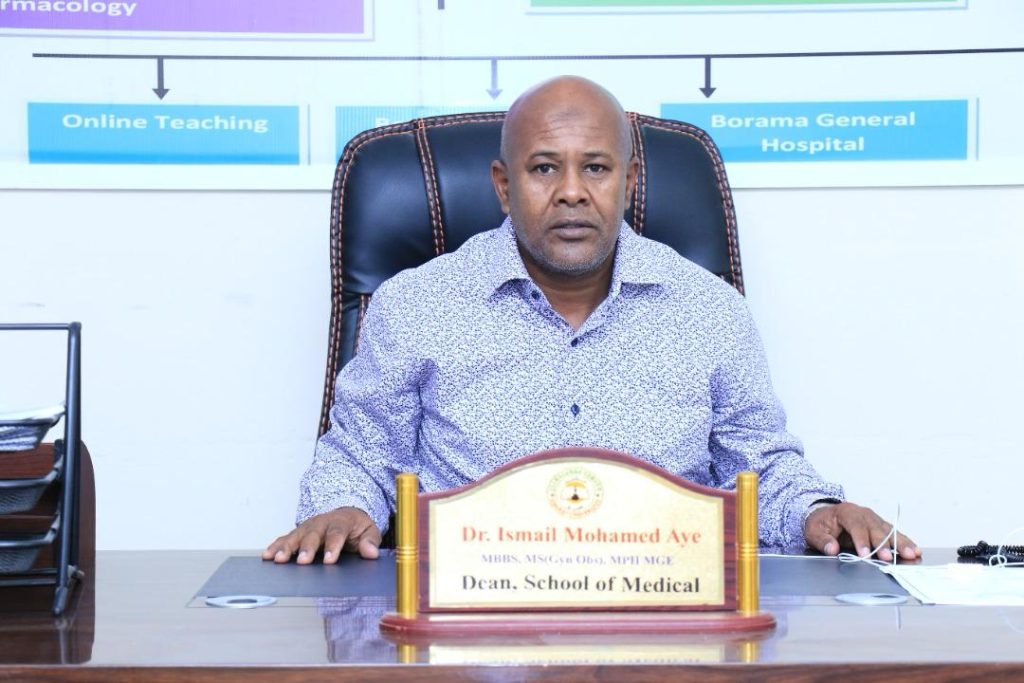

School of Medicine and Surgery
About the School
Vision
To become a leading institution of higher learning of good international repute providing home-grown, real-time and research-based solutions to the myriad problems encountered in Computing and, Information Communication and Technology areas and to be the regional electronic hub for fostering peace and development, through enhanced communication.
Mission
To respond positively to evolving socio-economic needs by designing and implementing computing and informatics education programmes that produce graduates with knowledge, skills and competencies to discern problems and design software solutions that reflect and contextualize diversity at all levels.
Objectives
The objectives of faculty of computing an informatics are:
- To churn out highly qualified professionals whose knowledge base and grasp of computing and informatics are unmatched locally and beyond.
- To produce techno-savvy graduates capable of matching the challenges of this fast dynamic digital age, who can create job opportunities for themselves and for others by applying the global multifaceted world of computing and informatics concepts.
- To spearhead academic research and publication in the horn of Africa region by both staff and students at the faculty, and application of the proposed solutions from such research activities to help solve the myriad range of computing and information communication and technology problems facing the horn of Africa and the international community at large.
History & Background
Established in 2000-2001 after the collapse of the Somali central government, the School of Medicine at Amoud University was the first of its kind in the region. Initially offering a six-year medical program, it later transitioned to a five-year program aligned with the harmonized curriculum of Somaliland medical schools, leading to a Bachelor of Medicine and Surgery (MBBS).
The curriculum, developed post-Somali central government era, initially followed a traditional structure. However, exposure to modern medical education trends and other schools led to continuous revisions. An integrated curriculum was eventually adopted to meet evolving educational and healthcare delivery needs.
The school’s first curriculum was developed based on experiences from visits to medical schools in Sudan and Egypt, sponsored by WHO. Goals included making medical education relevant to community needs, introducing students to community needs early, and producing competent doctors.
With an initial 15 students and two lecturers, the school has grown to 35 lecturers and 357 students. Most lecturers are school graduates who completed postgraduate studies abroad. The school has 375 graduates working within Somaliland and Somalia.
Challenges included a lack of health professionals in the region, skepticism from local communities about establishing the school, and limited resources and facilities. Despite these challenges, the school has made significant progress, offering a range of medical disciplines and continuing education programs. It serves as a medical resource center for healthcare professionals and organizations involved in healthcare.
School Stats
Enrolled Students
Graduated Doctors
Academic Staff
School Programs
Bachelor of Medicine and Surgery (MBBS)
The Bachelor of Medicine and Surgery (MBBS) program at the School of Medicine at Amoud University was initially structured as a six-year medical studies curriculum. However, it later transitioned to a five-year program in alignment with the harmonized curriculum of Somaliland medical schools. The program aims to produce competent doctors capable of working in both urban and rural areas as part of health teams, while also fostering problem-solving and lifelong learning skills among its students.
The curriculum for the MBBS program was developed based on experiences gained from visits to medical schools in Sudan and Egypt, which were sponsored by the World Health Organization (WHO). This curriculum takes into consideration the current health needs of the Somali-speaking regions, ensuring that graduates are well-equipped to address the specific health challenges of their communities.
Since its inception, the MBBS program has experienced significant growth. It began with an initial cohort of 15 students and two lecturers, and has since expanded to accommodate 357 students and 35 lecturers. Most of these lecturers are graduates of the school who completed their postgraduate studies abroad and have returned to serve their communities, highlighting the program’s commitment to local capacity building and retention of talent.
Overall, the MBBS program at the School of Medicine at Amoud University plays a crucial role in addressing the pressing need for doctors and other health professionals in Somaliland and Somalia. It is part of the school’s broader mission to produce well-prepared graduates who can make meaningful contributions to healthcare delivery in the region.
School Management Team

Contact us
Address
- AUCHS Main Campus, Near Rays Hotel, Borama.
Emails
- medicalschool@amoud.edu.so
- auchs@amoud.edu.so
Phone
- +252 634 456 233
- +252 634 505 569

